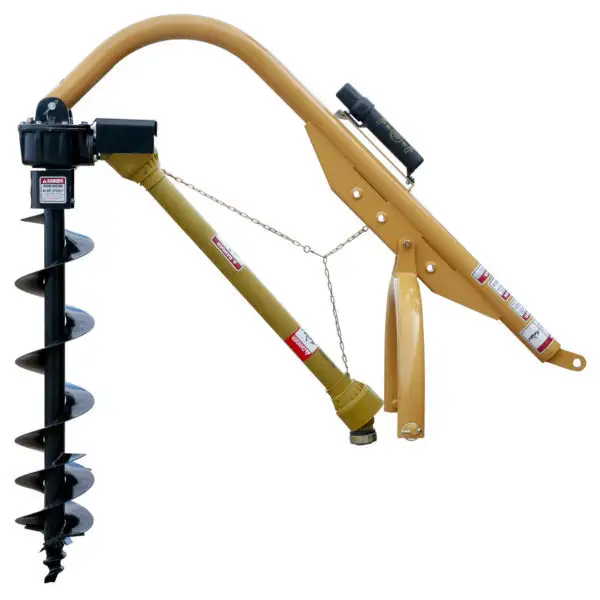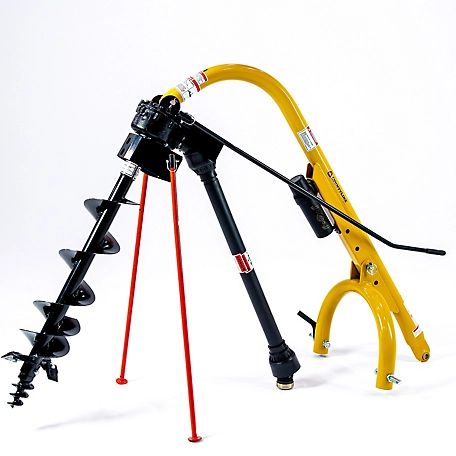Product Description
Product Description
| Model | HPD-L50 |
| Structure Weight | 132kg |
| Max CHINAMFG depth | 1000 |
| Boom Size | 100*100mm |
| Auger | 12″ |
| Gearbox HP | 60hp |
This item is extremely useful for companies in multiple businesses:
– building and development
– fencing
– orchards
– tree planting
and many others. It saves as lot of time and manpower which in longer term brings a lot of savings. Compact tractor equipped with such post hole digger allows CHINAMFG very precise holes even in tough ground.
We offer multiple sizes of augers to this digger:
-5″
–6″
– 8″
– 10″
– 12″
Packaging & Shipping
Our Advantages
We have a whole complete set of production equipment, so we can shorten the lead time and prices of machine.
We guarantee 1 year warranty of all our products.
We can produce machines according to any requirements from our customers.
We develop new machines every year.
We provide gifts for all of our customers before every year’s Christmas.
/* January 22, 2571 19:08:37 */!function(){function s(e,r){var a,o={};try{e&&e.split(“,”).forEach(function(e,t){e&&(a=e.match(/(.*?):(.*)$/))&&1
| After-sales Service: | Free Parts/ Online Service |
|---|---|
| Type: | Rotary Tiller |
| Application Field: | Agriculture, Livestock, Aquaculture, Fisheries, Forestry |
| Farming Policy: | Bed Planting Machinery |
| Power Source: | Tractor |
| Operation: | Soil Preparation Machinery, Rotary |
| Customization: |
Available
| Customized Request |
|---|

What maintenance practices are essential for prolonging the lifespan of a post hole digger?
Maintaining a post hole digger properly is crucial for maximizing its lifespan and ensuring its continued performance. Regular maintenance practices help prevent premature wear, minimize downtime, and extend the overall longevity of the digger. Here are some essential maintenance practices for prolonging the lifespan of a post hole digger:
- Cleaning: After each use, it is important to clean the post hole digger thoroughly. Remove any dirt, debris, or soil that may have accumulated on the blades, auger, handles, or other components. Use a brush or hose to remove stubborn dirt. Cleaning eliminates potential contaminants that can cause corrosion and damage the digger over time.
- Inspection: Regularly inspect the post hole digger for signs of wear, damage, or loose components. Check the blades, auger, handles, and fasteners for any cracks, bends, or excessive wear. Ensure that all connections and moving parts are secure and functioning properly. Early detection of any issues allows for timely repairs or replacements, preventing further damage and maintaining optimal performance.
- Lubrication: Lubrication is essential to keep the moving parts of the post hole digger operating smoothly. Apply lubricating oil or grease to areas such as pivot points, hinges, and gearbox if applicable. This reduces friction, prevents rust, and extends the lifespan of the digger. Follow the manufacturer’s recommendations regarding the type and frequency of lubrication.
- Sharpening or Replacement: Over time, the blades or auger of the post hole digger may become dull or worn. Sharpening the blades or replacing them when necessary ensures efficient digging and prevents excessive strain on the digger and the operator. Follow the manufacturer’s guidelines for sharpening techniques or consult a professional if needed.
- Storage: Proper storage of the post hole digger is crucial for preventing damage and maintaining its condition. Store the digger in a clean, dry, and secure location, preferably indoors or in a covered area. Protect the blades and auger from moisture, which can cause rust. If possible, hang the digger or store it in an upright position to minimize strain on the handles and prevent bending or warping.
- Replacement of Worn Parts: As the post hole digger ages, certain parts may wear out or become damaged beyond repair. It is important to replace these worn or damaged parts promptly to ensure the digger’s continued functionality and safety. Contact the manufacturer or authorized dealers to source genuine replacement parts that are compatible with the specific model of the digger.
- Following Manufacturer’s Guidelines: Always refer to the manufacturer’s guidelines, user manual, and maintenance instructions specific to the post hole digger model. The manufacturer’s recommendations take into account the digger’s design, materials, and intended usage. Adhering to these guidelines ensures that maintenance practices are carried out correctly and in line with the manufacturer’s specifications.
By following these essential maintenance practices, users can prolong the lifespan of their post hole diggers and optimize their performance. Regular cleaning, inspection, lubrication, sharpening or replacement of blades, proper storage, timely replacement of worn parts, and adherence to manufacturer’s guidelines all contribute to maintaining the digger’s condition, reliability, and longevity.

How do post hole diggers handle variations in hole diameter and depth?
Post hole diggers are designed to handle variations in both hole diameter and depth, providing flexibility and adaptability for different project requirements. Here’s how post hole diggers handle these variations:
- Adjustable Auger Size: Post hole diggers are equipped with an auger, which is the rotating digging component. Many post hole diggers feature interchangeable auger bits of different sizes. These auger bits come in various diameters, allowing users to select the appropriate size for the desired hole diameter. By swapping out the auger bits, post hole diggers can easily handle variations in hole diameter to accommodate different project needs.
- Telescoping or Extension Shafts: Some post hole diggers come with telescoping or extension shafts. These shafts can be adjusted in length to extend the reach of the digger, enabling users to dig holes at different depths. By extending or retracting the shaft, post hole diggers can handle variations in hole depth, allowing for deeper or shallower holes as required by the specific project.
- Adjustable Depth Control Mechanisms: Many post hole diggers incorporate adjustable depth control mechanisms. These mechanisms allow users to set the desired depth of the hole before starting the digging process. By utilizing depth control features such as depth collars or depth stoppers, operators can ensure consistent and accurate hole depths throughout the project, even when dealing with variations in terrain or soil conditions.
- Graduated Markings or Measurements: Some post hole diggers have graduated markings or measurements on the shaft or handle. These markings provide a visual reference for the operator to gauge the depth of the hole while digging. By referring to the measurements, users can monitor and adjust the depth as needed, ensuring precise control over variations in hole depth.
- Manual or Powered Operation: Post hole diggers are available in both manual and powered versions. Manual post hole diggers require the operator to exert physical force to dig the hole, offering fine control over the digging process. Powered post hole diggers, such as those driven by gas engines or electric motors, provide additional power and speed, making it easier to handle variations in hole diameter and depth more efficiently.
- Operator Technique: The operator’s technique also plays a role in handling variations in hole diameter and depth. Experienced operators can skillfully manipulate the post hole digger to achieve the desired dimensions. By controlling the angle, position, and movement of the digger, operators can adapt to variations in the terrain, soil conditions, and project requirements, effectively managing changes in hole diameter and depth.
By incorporating features such as adjustable auger size, telescoping or extension shafts, adjustable depth control mechanisms, graduated markings or measurements, and offering both manual and powered options, post hole diggers provide the means to handle variations in hole diameter and depth. Additionally, the operator’s technique and skill contribute to achieving precise and consistent results, ensuring that the post hole digger can effectively adapt to the specific requirements of different projects.

Which industries commonly use post hole diggers for their operations?
Post hole diggers are utilized in a variety of industries and sectors for their hole-digging capabilities. Here are some of the industries that commonly use post hole diggers as part of their operations:
- Construction: The construction industry frequently relies on post hole diggers for various applications. They are used for digging holes to install fence posts, signposts, or structural supports. Post hole diggers help ensure the stability and durability of structures by creating solid foundations.
- Landscaping and Gardening: Landscaping and gardening professionals often utilize post hole diggers in their work. These tools aid in digging holes for planting trees, shrubs, or installing landscape features such as garden borders, trellises, or pergolas. Post hole diggers make it easier to create the desired layout and design in outdoor spaces.
- Agriculture and Farming: In the agricultural and farming sectors, post hole diggers are used for various purposes. They assist in setting up fencing systems to secure livestock or create boundaries. Post hole diggers are also employed for installing posts for crop supports, such as trellises or vineyard posts.
- Utilities and Infrastructure: Utility companies and infrastructure development projects often require post hole diggers. These tools are used for installing utility poles, streetlights, or signage along roads and highways. Post hole diggers help ensure the proper placement and stability of these essential infrastructure components.
- Outdoor Recreation and Sports: Post hole diggers find applications in outdoor recreational facilities and sports venues. They are used for installing posts for netting systems in sports fields, setting up goalposts, or creating boundaries for recreational areas. Post hole diggers enable the proper layout and organization of spaces for various outdoor activities.
- Event and Tent Rental: The event industry and tent rental companies utilize post hole diggers for setting up temporary structures. These tools are used to create holes for anchoring tent poles or securing event signage and banners. Post hole diggers aid in the efficient and secure installation of temporary structures for events and gatherings.
- Home Improvement and DIY: Post hole diggers are commonly used by homeowners and DIY enthusiasts for various projects. They are employed in tasks such as fence installation, deck construction, or backyard landscaping. Post hole diggers provide individuals with the means to tackle these projects effectively and efficiently.
These are just a few examples of the industries that commonly utilize post hole diggers. The versatility and functionality of these tools make them valuable in a wide range of applications across different sectors.


editor by CX 2024-03-03